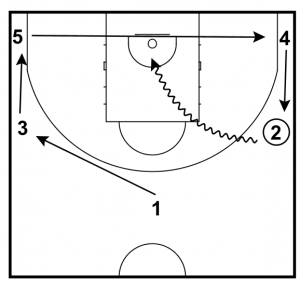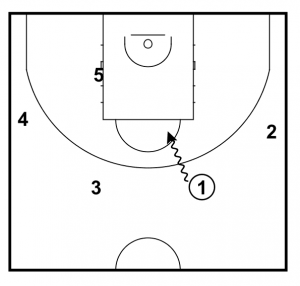Attack Dribble Breakdown
Since this Attack Dribble breakdown is the first layer we have covered, we are only able to execute one action at a time for two reasons.
1. Players don’t know what to do when they pass the ball.
2. Players don’t know how to react in the post.
This will change when Post Slides and Pass & Cut are added to the mix. In the meantime, we will make a rule for all drills that says when a player passes, they are off the court and out of the drill along with the player who was defending them if applicable. This will allow us to practice multiple Attack Dribble actions when 3 or more people are on the court.
A. 5 offensive perimeter players 0 defenders 1 Attack Dribble
5 out or 3 out 2 in
Locate 5 players at the 5 perimeter spots. The player with the ball attacks the lane with one dribble. Each player rotates one perimeter spot in the direction of the penetration. Ball handlers should always recognize their natural pitch and their safety from each location. Place the ball in each spot and show the rotations for one attack dribble from each spot. All penetrations should be shown except for baseline penetration. Baseline penetrations and rotations will be covered in the second sub-layer.
The player #3 in the diagram is the Pitch.
The player #2 in the diagram is the Safety.
#1 would first look to score, then read the help and pass to the open player.
If 1 passes to the Pitch, they would fill out to the empty spot on the opposite side as 2, 4, and 5 filled the empty spots.
If 1 passes to the Safety player, they would fill out to the corner that 5 didn’t fill. This provides an interesting screening opportunity (we will cover that much later).
Keep in mind that the above diagram shows where players would be if there was only one action. It’s impossible to predict what will happen next, but no matter what happens, your players will know what to do. If #1 shoots, then they will either rebound or play transition defense. If #1 passes, the receiver might shoot, dribble, or pass. It doesn’t matter what they do, the other 4 players will know what to do. In addition, #1 has options after their pass. We’re not ready to talk about those options yet, but we will soon. As multiple actions are tied together, players react to these actions making their placement unpredictable. These strings of back to back unpredictable actions make the offense very difficult to defend.
4 out 1 in
Locate 4 players at 4 of the 6 perimeter spots. The post player should not be included. The player with the ball attacks the lane with one dribble. Each player rotates one perimeter spot in the direction of the penetration. Ball handlers should always recognize their natural pitch and their safety from each location. Place the ball in each spot and show the rotations for one attack dribble from each spot. There are a few different combinations of player locations in 4 out. All possible combinations should be shown. All spots 1 pass away from the ball should always be filled. All penetrations should be shown except for baseline penetration. Baseline penetrations and rotations will be covered in the second sub-layer.
The player #3 in the diagram is the Pitch.
The player #2 in the below is the Safety.
Notice in the last drawing that 1 has not filled the other top guard spot. This fill is optional. There are advantages to 1 staying on the wing as well as advantages to 1 filling up to 2. These advantages will be discussed in future posts. The post also has a number of options as well. These will be discussed in the upcoming layers.
3 out 2 in
Locate 3 players at 3 of the 5 perimeter spots. This should look the same as 5 out with two open perimeter spots. The post players should not be included. The player with the ball attacks the lane with one dribble. Each player rotates one perimeter spot in the direction of the penetration. Ball handlers should always recognize their natural pitch and their safety from each location. There are a few different combinations of player locations in 3 out 2 in. All possible combinations should be shown. Always fill spots 1 pass away from the ball. Place the ball in each spot and show the rotations for one attack dribble from each spot. All penetrations should be shown except for baseline penetration. Baseline penetrations and rotations will be covered in the second sub-layer.




